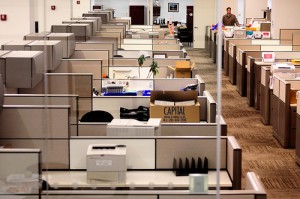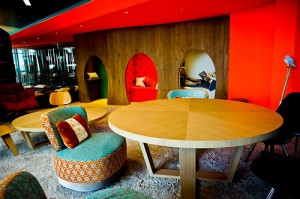
Wall-to-wall cubicles might have been okay to attract the country’s top talent 10 years ago, but today’s young workers are looking for a little more style and a lot more room for creativity.
Office furniture does more than offer a space for employees to sit 40 hours a week. It also has the power to attract (or drive away) the best and the brightest job candidates.
In recent years, cubicles have become the crazy uncle of the office furniture family that nobody quite knows what to do with.
For generations of workers, they served the function of offering a semi-private, quiet workspace in which employees would retreat to for eight hours a day, breaking only for coffee and a run to the restroom.
But they’re quickly becoming relics of an era where vying for the corner office was more valued than contributing to the greater good. These days, young talent on the search for a job aren’t as impressed by the promise of their own office and stock options. Instead, they want their workplace to be a creative environment that reflects their values and interests.
“There is a saying about the role of design which can be summed up in the acronym ARM: Attract, Retain, Motivate. After location, design is the first thing many potential employees will notice. As they say, you rarely get a second chance to make a first impression!” Paul Finch, director of the World Architecture Festival, told consulus.com.
If job candidates take a tour of a workplace that’s a poorly lit maze of high-walled cubicles, chances are they won’t want to stick around for too long.
You want staff to look forward to being in the office and also excited to show it off to clients and even friends and family. If it’s a place that employees take pride in working in, this can improve retention rather than if it’s some place employees feel embarrassed about or that makes them feel depressed.
What Talented Job Hunters are Looking For
Generation Y has plenty of demands when it comes to the ideal work environment.
In a poll by MonsterTRAK on green employment, 92 percent of the young professionals who were interviewed said they would prefer to work for a company that was environmentally friendly, according to a story on FreeEnterprise.com. Other surveys have found similar results.
Traditional offices with their high walls and corner offices are more about conveying who’s in charge and which department goes where. But top talent isn’t looking for hierarchy and bureaucracy. They want to work at a place that tears down walls and promotes new ideas, creativity and collaboration. Beyond promoting teamwork, open offices tend to allow more natural light and airflow: more must-haves for young recruits. Many companies are responding to these trends by lowering cubicle walls to below 50 inches.
The younger generation is also looking for easy ways to stay plugged in, so simple considerations like making sure there are convenient power sources throughout the office for smartphones, laptops and tablets is critical. Increasingly, office furniture and accessories like coffee tables or floor lamps have charging stations built in for this very reason.
A survey by Knoll found that members of Generation Y prefer quick, casual meetings rather than lengthy ones held in formal spaces, according to CNN.com. In addition to more traditional conference rooms, creating seating areas throughout the office for these type of run-ins is key.
Finally, because the line between work life and personal life is blurred for younger recruits, they want their office space to feel a little more homey than previous generations, according to CNN.
What Types of Office Furniture Attracts Talent?

There’s a reason Google always manages to attract the best people. For one, it’s Google, but it also is known for unique, fun workspaces that inspire collaboration and new ideas.
While high-walled cubicles are losing favor among designers and employers alike, low-walled cubicles that offer some privacy while still allowing for easy conversation and access to natural light, etc. are still a good workspace option.
In fact, the biggest complaint about the open office trend seems to be the noise levels and lack of privacy, so cubicles with wall heights under 50 inches might offer the best compromise.
Beyond that, you want to consider comfort and health, finding pieces (chairs especially) that are ergonomically friendly and reduce fatigue and strain.
Because young recruits are so environmentally conscience, one way to attract their attention is by purchasing furniture that has a small footprint. Maybe it’s made with recycled material and is recyclable itself or you bought it used (rescuing it from a lifetime in the landfill). It doesn’t hurt to point out other green initiatives your company is taking: recycling, using power-saving office equipment, more efficient heating and air conditioning, etc.
Look for ways to add pops of bright, energizing color throughout the office. Couches and chairs in more casual meeting spaces are ideal places to introduce color. Try to have fun; we’re not saying you have to have clowns running around your building (that’s just creepy), but a foosball table in the break room or some oversized beanbag chairs in a conference room show that you understand that the creative process isn’t all about spreadsheets and expense reports.





